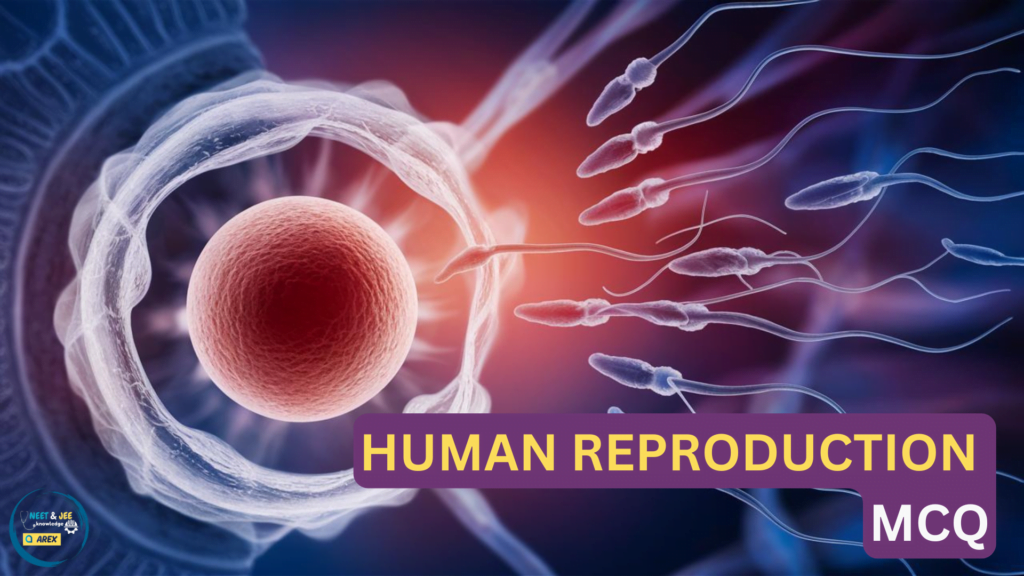
Human Reproduction NEET MCQ with Answers
Human reproduction involves the creation of new life through the fusion of male and female gametes. In males, the reproductive system includes the testes, which produce sperm and associated ducts and glands that help in the transport and delivery of sperm. In females, the reproductive system comprises the ovaries, which produce eggs (ova) and structures like the fallopian tubes, uterus and vagina.
The process begins with the production of gametes through spermatogenesis in males and oogenesis in females. Fertilization occurs when a sperm successfully penetrates an egg, leading to the formation of a zygote. The zygote undergoes several divisions and implants itself into the uterine wall, developing into an embryo.
The human reproductive system is not just about producing gametes and fertilization; it also includes hormonal regulation and the menstrual cycle in females. The menstrual cycle prepares the female body for potential pregnancy and involves the cyclical production of hormones like estrogen and progesterone. Understanding these processes is very important for NEET students, as it forms a significant part of the biology syllabus.
| NEET 2025 Exam Important Links | |
|---|---|
| NEET 2025 Updated Syllabus | NEET Eligibility Criteria 2025 |
| Biology Preparation | Chemistry NEET Preparation |
| NEET Preparation tips for 2025 | NEET Result 2024 |
Human Reproduction NEET MCQ with Answers
Human Reproduction is a critical topic in the NEET syllabus because it provides fundamental knowledge about the reproductive system, essential for aspiring medical professionals. Understanding the structure and functions of male and female reproductive systems, gametogenesis, menstrual cycle and fertilization processes is vital for diagnosing and treating reproductive health issues.
Moreover, Human Reproduction is frequently covered in NEET exams, making it an important area for scoring well. Mastery of this topic helps students answer multiple-choice questions accurately and efficiently, boosting their overall performance. Studying human reproduction helps students grasp fundamental concepts of developmental biology, genetics and the continuity of life.
MCQ for NEET

Each testis (A) possesses about 250 compartments called testicular lobules.
Seminal vesicle (B) secretes mucous and a watery alkaline fluid rich in nutrients like fructose, citric acid, inositol and prostaglandins. It provides energy to the spermatozoa.
Prostate gland (D) releases an alkaline fluid that is rich in citrate ions, calcium phosphate and proteolytic enzymes to aid in sperm motility.
Enhance your preparation with Arexiq’s Mock Test Series where we provide solutions to various MCQs like we provide in this post “Human Reproduction NEET MCQ”. Our expert teachers explain the concepts thoroughly, making it easy for you to understand. We offer many types of questions ensuring a clear grasp of concepts.
FAQs about Human Reproduction
1.What are the main organs involved in the male reproductive system?
Answer. The main organs are the testes, vas deferens, seminal vesicles, prostate gland, and penis.
2. What is the role of the ovaries in the female reproductive system?
Answer. The ovaries produce eggs (ova) and secrete hormones like estrogen and progesterone.
3. What is fertilization?
Answer. Fertilization is the process where a sperm cell from a male fuses with an egg cell from a female to form a zygote.
4. What is the menstrual cycle?
Answer. The menstrual cycle is a monthly process in females that prepares the body for pregnancy, involving the shedding of the uterine lining if fertilization does not occur.
5. What happens after fertilization?
Answer. After fertilization, the zygote undergoes multiple cell divisions and implants itself into the uterine wall, developing into an embryo.


